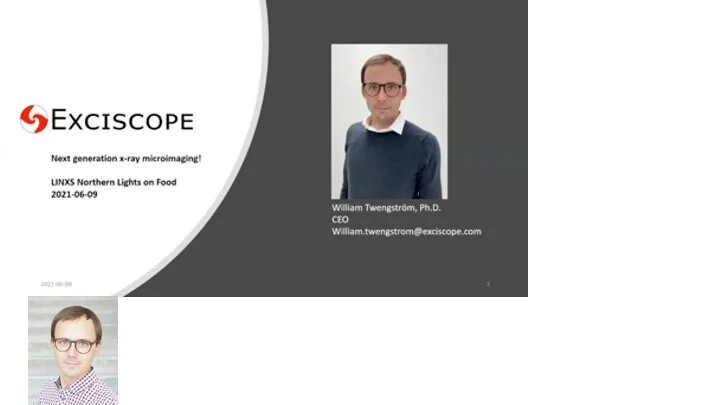VIDEO - Northern Lights on Food II workshop - Towards tabletop 4D imaging of low-density food products using x-ray phase contrast with William Twengström


VIDEO - Northern Lights on Food II workshop - Towards tabletop 4D imaging of low-density food products using x-ray phase contrast with William Twengström
Speaker: William Twengström, Exciscope AB, Sweden
This lecture was part of the workshop, Northern Lights on Food II, organised on June 9-11, 2021, by the LINXS working group Food, with support from Formas.
Abstract
Detailed imaging of the food we eat widens our understanding of its structure and helps us to optimise ingredients and production techniques. Recent and established imaging techniques within the food science field are e.g. light and electron microscopy methods, as well as X-Ray Computed Tomography (XCT), Magnetic Resonance Imaging (MRI) and Neutron Tomography (NT) [1]. In contrast to microscopy techniques, which often require advanced and time-consuming sample preparations, tomographic imaging techniques, such as XCT, MRI and NT often have no such requirements. XCT has already been used for decades to non-destructively investigate, e.g., muffins, marshmallows and meat, but with limited contrast in samples with small density variations due to weak x-ray attenuation [2,3]. On the other hand, detecting not only attenuation, but also phase shift, enables high-resolution imaging of low-density materials, such as protein, carbohydrates and fat. If image acquisition is fast enough, time-resolved volume data sets can be acquired. Synchrotron radiation 4D x-ray microtomography in combination with phase contrast has already been demonstrated on both bread during baking [4] and microstructural stability in ice-cream [5], and great technical developments in 4D imaging have been shown in recent years [6]. Synchrotron beamlines are able to produce state-of-the art images, where two access routes currently exist: 1) peer-review accessibility, if the aim is to publish the results and 2) paid industry beamtime, without the requirement of publishing. However, both access routes often involve a waiting time up to 3-6 months. If on the other hand time-resolved micro-CT of food products were to be performed in a local laboratory, waiting time and cost can be reduced. In this study, we used lab-based phase-contrast CT to demonstrate imaging of different low-density food products, such as bread, potato chips, tomatoes and cheese doodles. Our propagation-based phase-contrast system is based on a liquid-metal-jet microfocus x-ray source (MetalJet D2, Excillum, Sweden) [7] and enables high-resolution tomography of centimetre-sized samples in a few minutes. For example, it can be used to differentiate between fat, carbohydrates and air in cheese doodles (Fig. 1a), as well as visualisation of fine internal structures and air cavities in potato chips and bread. Results obtained with phase-contrast micro-CT were compared to confocal laser scanning microscopy (CLSM) images of similar samples (Fig 1b), acquired with a Leica system (TCS SP5 AOBS, Heidelberg, Germany). Fat is found inside some of the pores in the cheese doodle, predominately close to the surface. The different components in the structure, the corn matrix, fat and air blisters, correspond well between CLSM and X-ray phase-contrast CT images. By further optimisations, the total micro-CT acquisition time can be reduced to 10-30 seconds per scan, which opens up for time-resolved studies of, for example, extrusion or melting processes.
These developments lead the way towards performing 4D analysis of food products closer to the production line, thus further refining the processes of making tasty, healthier and more cost-efficient food products.
